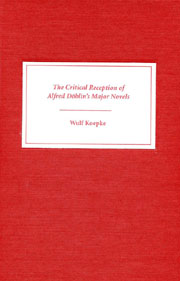Book contents
- Frontmatter
- Contents
- Preface
- Major Novels by Alfred Döblin
- Introduction
- Part One Contemporary Reviews
- Part Two Döblin Scholarship
- 3 Döblin Scholarship: The First Approaches
- 4 Die drei Sprünge des Wang-lun
- 5 Wadzeks Kampf mit der Dampfturbine
- 6 Wallenstein
- 7 Berge Meere und Giganten
- 8 Manas
- 9 Berlin Alexanderplatz
- 10 Babylonische Wandrung
- 11 Pardon wird nicht gegeben
- 12 Amazonas
- 13 November 1918
- 14 Hamlet oder Die lange Nacht nimmt ein Ende
- 15 Döblin's Impact on Other Writers
- Conclusion
- Bibliography
- Index
4 - Die drei Sprünge des Wang-lun
from Part Two - Döblin Scholarship
Published online by Cambridge University Press: 05 February 2013
- Frontmatter
- Contents
- Preface
- Major Novels by Alfred Döblin
- Introduction
- Part One Contemporary Reviews
- Part Two Döblin Scholarship
- 3 Döblin Scholarship: The First Approaches
- 4 Die drei Sprünge des Wang-lun
- 5 Wadzeks Kampf mit der Dampfturbine
- 6 Wallenstein
- 7 Berge Meere und Giganten
- 8 Manas
- 9 Berlin Alexanderplatz
- 10 Babylonische Wandrung
- 11 Pardon wird nicht gegeben
- 12 Amazonas
- 13 November 1918
- 14 Hamlet oder Die lange Nacht nimmt ein Ende
- 15 Döblin's Impact on Other Writers
- Conclusion
- Bibliography
- Index
Summary
WANG-LUN'S PUBLICATION in 1915 not only introduced Döblin as a new novelist to a wider audience, but also impressed many of his fellow writers and gave him an immediate standing in the literary community. However, it was later overshadowed by Wallenstein and Berlin Alexanderplatz, so that scholarly attention to Wang-lun was directed predominantly to a few areas: its depiction of the masses; the question of religion, specifically mysticism; the political meaning of “Wu-Wei,” non-violent resistance; and the image and idea of China and the question of exoticism.
Werner Falk published his article “Der erste moderne deutsche Roman: Die drei Sprünge des Wang-lun von Alfred Döblin,” in 1970. In it, he states that Wang-lun has been largely neglected up to that point in time. Modernity for him is the result of a deep-reaching change in history that asks for new responses. One of the features of modernity is that nature is no longer depicted for its own sake, but to reveal “Extranaturales” (515). Falk considers the primary quality of Wang-lun to be its entrancing rhythm, which carries the reader away (518). It is not a story of an individual, but of a collective, and this is a crucial feature of modernity (522). Collective forces have become the preoccupation of the age, and in this connection Falk reminds the reader of Heidegger and C. G. Jung. In Wang-lun, the conflict is between “Kollektivität und Egozentrik” (528).
- Type
- Chapter
- Information
- The Critical Reception of Alfred Döblin's Major Novels , pp. 84 - 95Publisher: Boydell & BrewerPrint publication year: 2003



